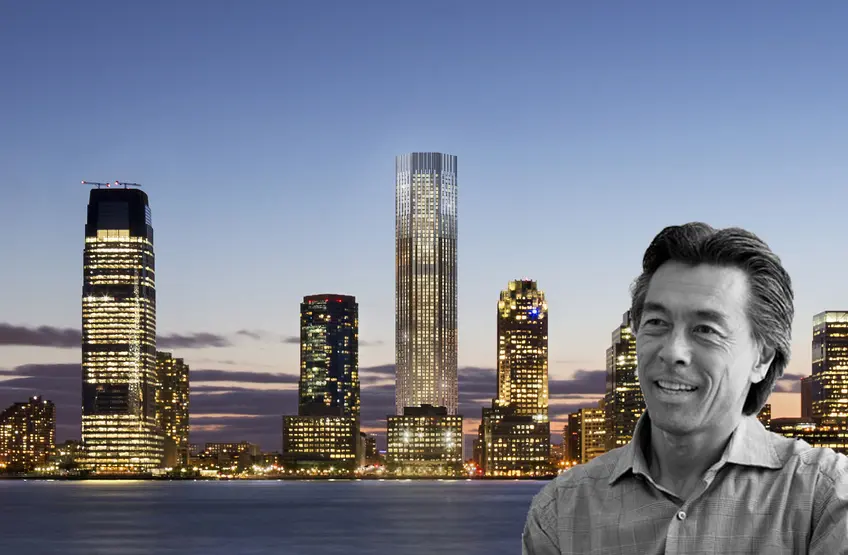 99 Hudson Street rendering from lower Manhattan (EE&K / Perkins Eastman Architects)
99 Hudson Street rendering from lower Manhattan (EE&K / Perkins Eastman Architects)
Ming Wu, a Principal at the architecture firm EE&K, a Perkins Eastman Company, the firm behind the massive downtown Jersey City residential project 99 Hudson, has lived all over the world and brings his global perspective to every project he works on. Ming Wu specializes in large-scale building projects and 99 Hudson continues that tradition. Already more than halfway up, the project will be the tallest building in New Jersey, and, beyond that, it will be the tallest purely residential building in the United States outside of Manhattan and Chicago.
CityRealty sat down with Mr. Wu to discuss his role in this massive project, how he brings his global perspective to Jersey City and how the building epitomizes the best of New York City.
CityRealty sat down with Mr. Wu to discuss his role in this massive project, how he brings his global perspective to Jersey City and how the building epitomizes the best of New York City.
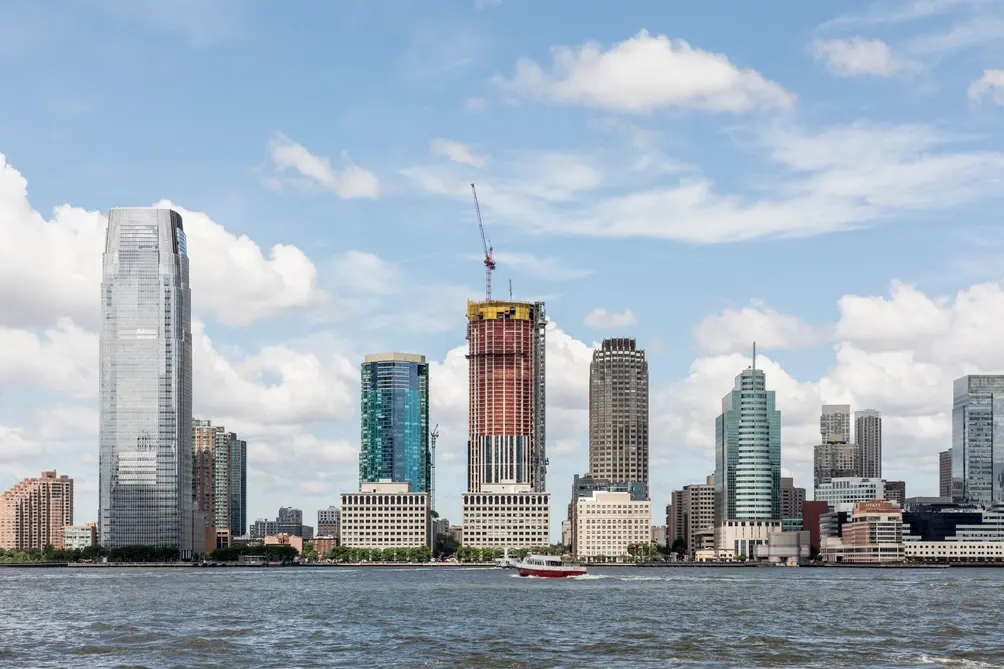 99 Hudson Street photos via Perkins Eastman Architects' Twitter feed
99 Hudson Street photos via Perkins Eastman Architects' Twitter feed
 via Perkins Eastman Architects
via Perkins Eastman Architects
Your bio on your website says you have lived all over the world. Where have you lived and how has it influenced your work?
I have lived in numerous location in the US, on both coasts, and in the heartland as well. I spent quite a number of years in Asia in my youth on different occasions as well. The time I spent not only abroad but also in several different U.S. locations and cities makes me particularly aware of my physical surroundings. From an early age, I became particularly interested in the built environment which lead to my interest in architecture. That very broad perspective of how cities are shaped around the world and why they are shaped the way they are are very useful tools in terms of what I do.
"This is a wonderful moment for Jersey City and as long as the New York economy remains vibrant and healthy, I think Jersey City will be riding Manhattan’s coattails for a long time to come." -Ming Wu
Does Jersey City remind you of any other city around the world?
I wouldn’t reference a particular city as one to compare to Jersey City but I do feel that right now the city feels very much like China to me, simply because there is so much growth that Jersey City is experiencing. The downtown is all torn up with construction everywhere you look and see tower cranes dotting the skyline. Jersey City feels like a city in a growth economy and China is certainly the largest growth economy. Anywhere you go in China, you get that same vibrancy in the city with how much construction is going on. Chinese cities are transforming and certainly, Jersey City is transforming too. This is a wonderful moment for Jersey City and as long as the Metropolitan New York economy remains vibrant and healthy, I think Jersey City will be riding Manhattan’s coattails for a long time to come.
Not only will this be the tallest building in New Jersey, it will be the tallest apartment building in the U.S. outside of Manhattan and Chicago. I know your expertise is in large-scale but why is this the right building for this site?
Put it simply, the value proposition that drives this building is the views. 99 Hudson will offer views of one of the world’s most iconic skylines. The residents of this building will have front row seats to one of the most spectacular views anywhere. Our objective, right from the start, has been to maximize the panorama to all of Manhattan and the Hudson River, stretching all the way from the Verrazano Bridge all the way north to the George Washington Bridge. Once we had created the largest footprint possible for the tower, there was really nowhere to go but up. So that’s why the building is as tall as it is — to capture as many floors of this really desirable, highly valuable view as possible.
The height was an important objective to achieve simply because in the larger market, 99 Hudson has to compete against all the residential condominium tower options in Manhattan, as well as the crop of tall towers in Brooklyn. As an alternative to living in in either of those locations, we wanted to do our part to give Jersey City a new identity in terms a skyline. Jersey City’s time has come.
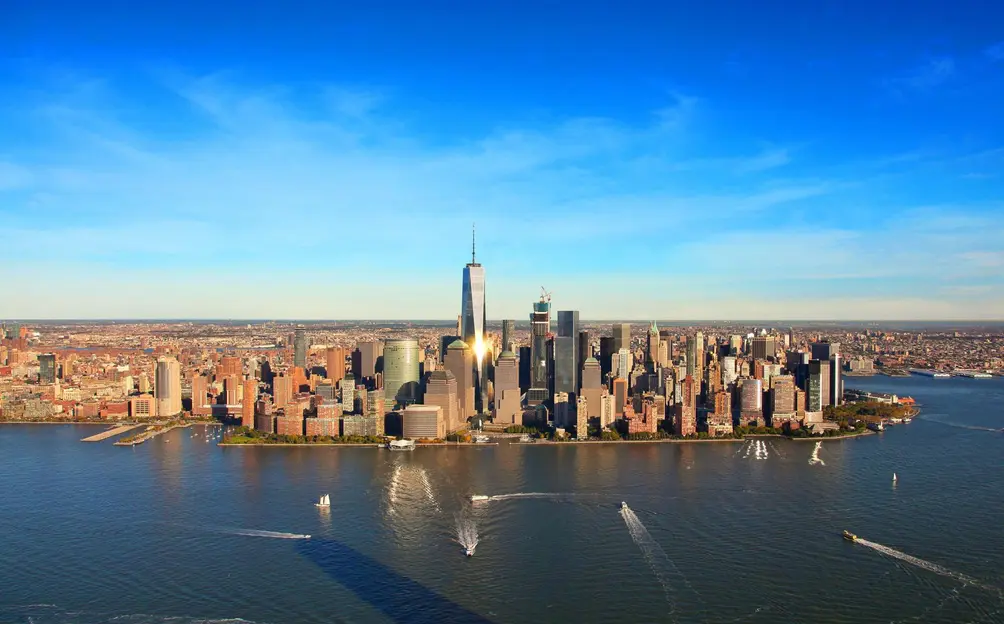 Anticipated view from high floor at 99 Hudson Street
Anticipated view from high floor at 99 Hudson Street
99 Hudson has 65,000 square feet of amenities is quite a package. What are the stand-out amenities?
One thing that is unique to this development is that we had a very large footprint. The building occupies an entire city block in downtown Jersey City. Because of that footprint, at the roof level, we have an area open to the sky upon which we’re building everything you could need or want. There will be a very generous roof garden, a very large pool, a dog run and also a number of barbeque stations. These features are special simply because we have such a large site with so much roof area which is uncommon when you look at the typical Manhattan or Brooklyn projects. That really sets us apart. The owners, China Overseas America, really went the extra mile. There’s also a golf simulator and a very nice spa occupies the 9th floor. The 8th floor opens out onto the roof deck and pool.
"Because of that footprint, at the roof level, we have an area open to the sky upon which we’re building everything you could need or want. "
One feature I like, which is not a part of the residential amenity package per se, is at the street level. Around the base of the building, where the building engages the public domain, we are providing 15,000 square feet of retail use for neighborhood services. That will be a much-welcomed amenity by not only the residents but by the surrounding neighborhood. Downtown is becoming more and more vibrant every passing year, with more and more people moving to Jersey City, who like the idea of living in a downtown with mass transit, specifically the PATH and light rail. At the street level where the building touches the ground, we wanted to facilitate a vibrant street life.
 99 Hudson Street views
99 Hudson Street views
99 Hudson is said to echo the Art Deco style. What made you choose that design?
I think it’s interesting that you say Art Deco. There are certain classifying references that the building makes and, by that I mean it was important to the 99 Hudson team, from the owner on down, that we convey a sense of reserve and dignity in regards to the architectural expression of the building. To my mind, that means that stone figures significantly in the materials palette for the tower, as it does throughout the New York City area. We used limestone which has traditionally been associated with fine residential construction. If you think of all the elegant big palazzos that line Fifth Avenue in Manhattan and that front Central Park, many of those buildings have been clad in limestone. Even in very recent times. quite a few of the high rise towers in Manhattan have been faced with the material. There are very direct associations between limestone and high-end residential design so we are using the limestone to honor and extend that tradition.
The limestone we’re using happens to be of German origin and it is a beautiful rich color and very durable. It will stand up to harsh weather conditions. Jersey City, the downtown area, in particular, is subject to very harsh winter winds, snow, and rain. Precipitation is the enemy of limestone. So we’re using one that is part dense and very impervious to moisture penetration.
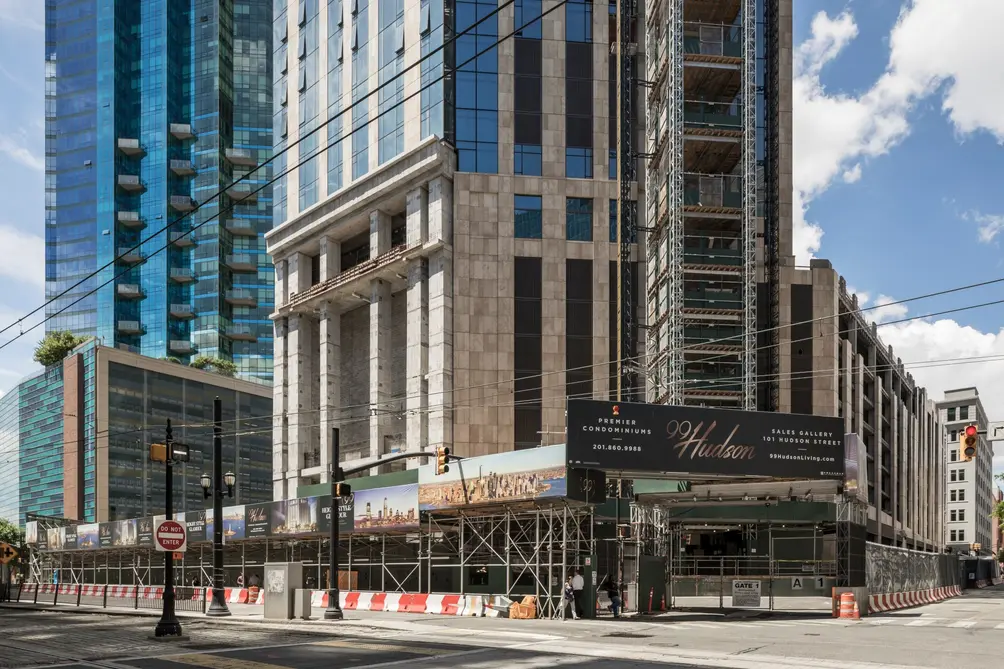 Limestone skin covering the structure (Perkins Eastman Architects)
Limestone skin covering the structure (Perkins Eastman Architects)
"There are very direct associations between limestone and high-end residential design so we are using the limestone to honor and extend that tradition."
Rather than Art Deco, I’d say, if anything, the design is something of a transitional nature. It is very solid at the base with a lot more limestone present in the lower reaches of the building. Stone is a material people relate well to. It has a warmth to it. As you get into the body of the tower, the stone becomes a series of strong vertical linear stone, pilaster lines alternating with glass. Then, you’ll see it next year sometime, as the cladding rises up in the building, at the top upper reaches of the building, it becomes very glassy. The building concludes with a very transparent top, a monumental lantern in the sky. It has a very modern sensibility.
So then did the inspiration for the porte-cochere come from Robert A.M Stern's recent buildings such as 15 Central Park West and the other luxury buildings in Manhattan?
I’m afraid I have to take the blame for the porte-cochere. Once we made the decision to integrate a parking compliment in the design of base of the building, it was such an easy leap from that to say: well, let’s connect the lobby, — make it a through lobby — connect the lobby from 99 Hudson directly to the parking facility — and once we have a through lobby, it was such a natural decision to create a porte-cochere. I think it’s a very special feature of the building and it is one that is rarely if ever, found in large residential buildings. Certainly, in Manhattan, where space is such a premium, it’s very to come by, it is an extra expense that the owner has to shoulder because it takes up space that could otherwise be revenue generating. A porte-cochere adds a touch of elegance to any building. It will just be more convenient and comfortable for residents dealing with the Jersey City weather since it will be totally enclosed. I think the people who come to live at 99 Hudson will really welcome this luxury amenity.
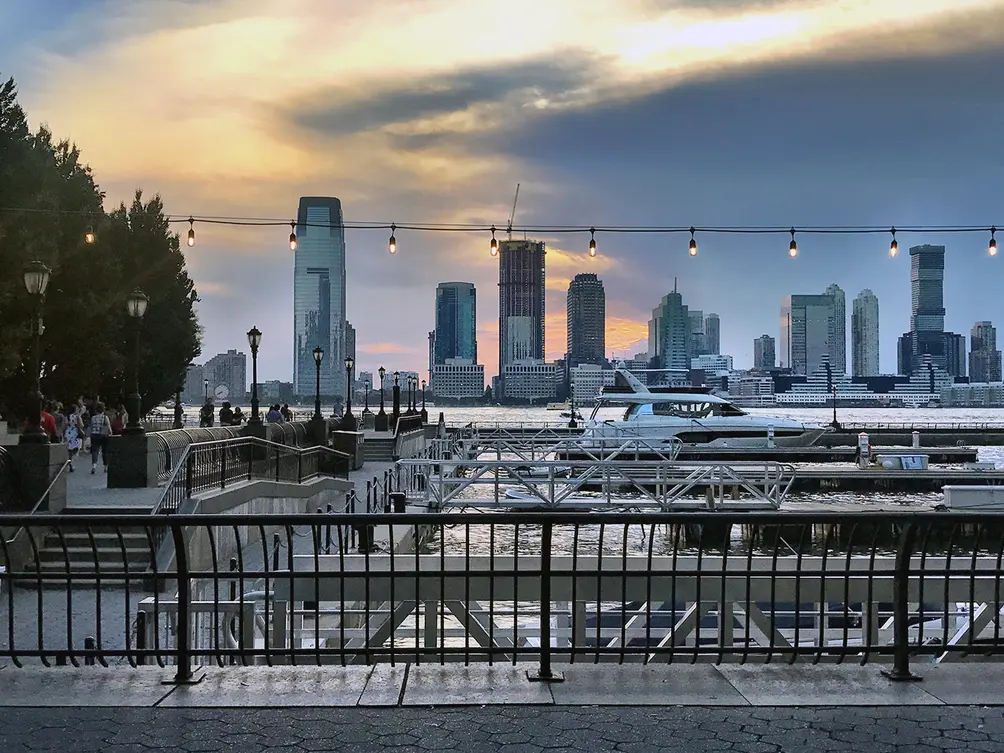 99 Hudson from Battery Park City in early July 2018 (CityRealty
99 Hudson from Battery Park City in early July 2018 (CityRealty

Contributing Writer
Michelle Sinclair Colman
Michelle writes children's books and also writes articles about architecture, design and real estate. Those two passions came together in Michelle's first children's book, "Urban Babies Wear Black." Michelle has a Master's degree in Sociology from the University of Minnesota and a Master's degree in the Cities Program from the London School of Economics.

 6sqft delivers the latest on real estate, architecture, and design, straight from New York City.
6sqft delivers the latest on real estate, architecture, and design, straight from New York City.
